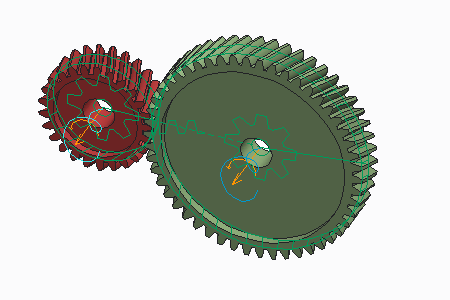Types of Dynamic Gear Pair
Each type of gear pair is defined by its motion axes, as shown in the table below.
Each type of gear pair is defined by its motion axes.
• Spur—Two cylinders that roll against each other where the pitch circle diameters meet. The reaction forces between the gears are calculated based on the transferred torque, the diameters of the gears and the manufacturing angles. Spur gears can have a helical angle and are also called helical spur gears.

• Bevel—Two cones that roll against each other where the pitch circle diameters meet. The reaction forces between the gears are calculated based on the transferred torque, the diameters of the gears and the manufacturing angles. Bevel gears can have a helical angle and are also called spiral bevel gears. When the axes are parallel, a bevel gear acts as a spur gear.

• Worm—Two gears of different sizes, where the worm body is smaller with a longer axis than the wheel body. Worm gears are defined as cylinders that slide against each other where the pitch circle diameters meet. Use when a large reduction ratio is needed.

• Rack and Pinion—Transfers rotational motion to translational motion or vice versa. A rack and pinion gear pair is defined as a cylinder that rolls on the pitch surface of the rack. The reaction forces between the gears are calculated based on the transferred torque, the separation of the gears and the manufacturing angles.
